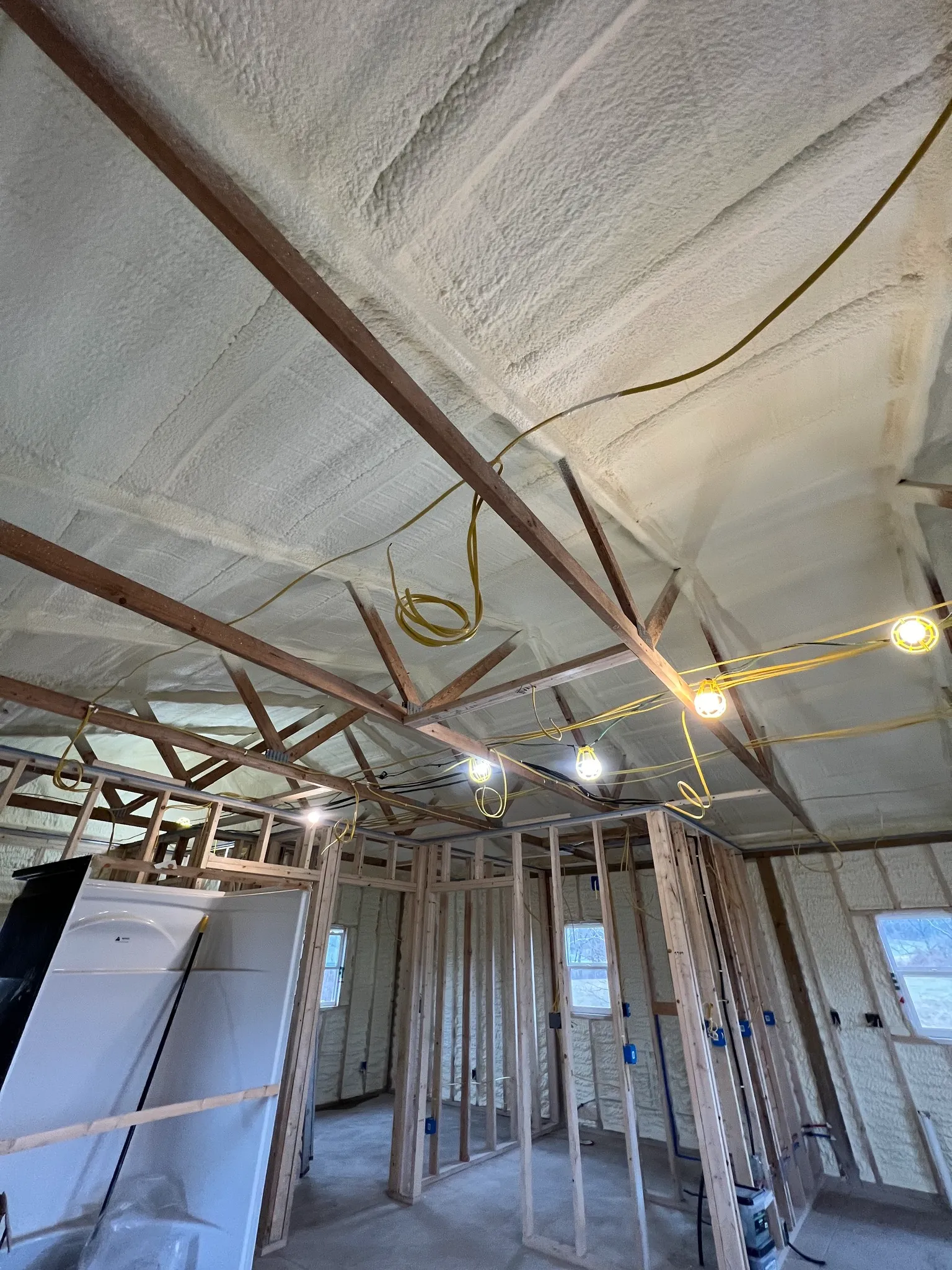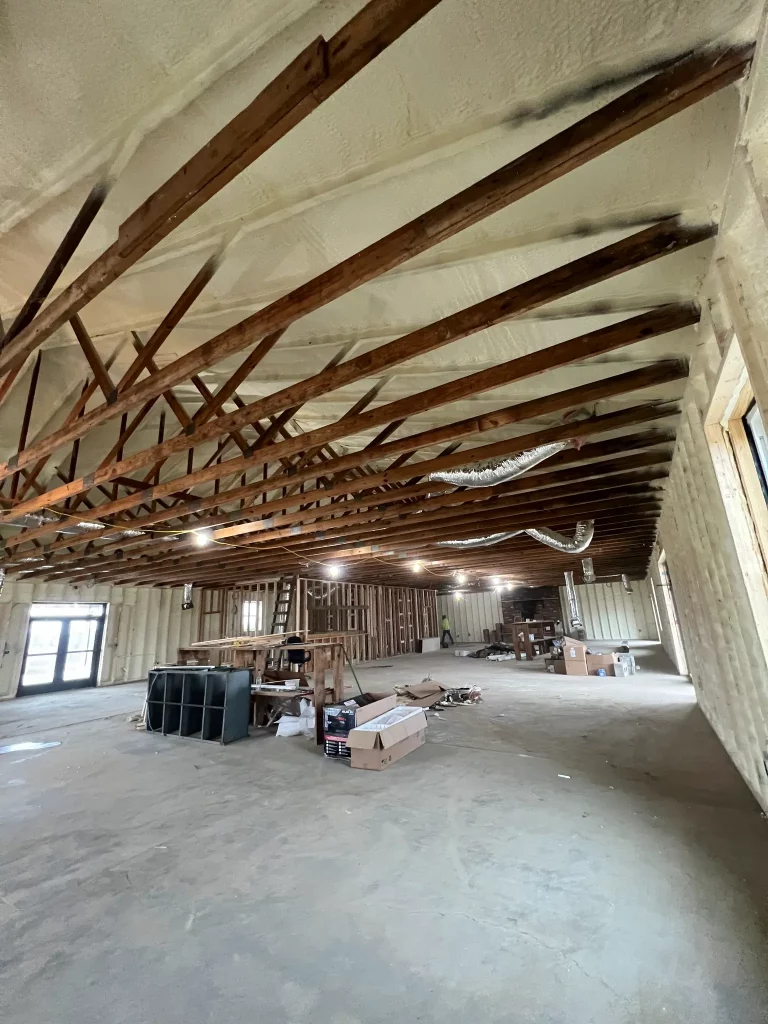
Spray foam insulation prevents mold growth by creating an airtight barrier that eliminates moisture infiltration and controls humidity levels within building structures. The closed-cell formulation acts as both an insulator and vapor barrier, blocking water vapor transmission while maintaining consistent interior temperatures that discourage mold formation.
This comprehensive approach addresses the three primary conditions mold requires to thrive: moisture, oxygen, and organic material. By controlling these environmental factors through superior air sealing and moisture management, spray foam creates inhospitable conditions for mold spores. Professional installation techniques developed through decades of field experience demonstrate measurable improvements in indoor air quality and structural integrity.
Mold requires specific environmental conditions to establish colonies within building materials. Temperature ranges between 77-86°F combined with relative humidity above 60% create optimal growing conditions. Traditional insulation materials like fiberglass and cellulose provide organic food sources while allowing air movement that transports moisture and spores throughout structures.
Spray foam disrupts this cycle by eliminating air infiltration pathways that carry moisture-laden air into wall cavities and attic spaces. The expanding foam fills gaps, cracks, and penetrations that conventional insulation cannot address, creating a continuous thermal and moisture barrier.
Bonus Tip: Monitor indoor humidity levels using digital hygrometers placed in multiple rooms. Consistent readings below 50% relative humidity indicate effective moisture control systems.
The primary defense against mold growth lies in comprehensive moisture management. Spray foam addresses both vapor transmission and bulk water intrusion through its chemical composition and application methods.
| Moisture Control Feature | Closed-Cell Foam | Open-Cell Foam | Traditional Insulation |
|---|---|---|---|
| Vapor Permeance (perms) | 0.8-1.5 | 15-20 | 50+ |
| Air Sealing Capability | Complete seal | Partial seal | No sealing |
| Water Absorption | <2% by volume | 5-10% by volume | 15-30% by volume |
| Structural Support | Yes | Limited | No |
Closed-cell spray foam provides superior vapor control with permeance ratings below 1.5 perms, classifying it as a vapor retarder under building codes. This characteristic prevents water vapor from penetrating wall assemblies where condensation could occur on cold surfaces.

Consistent surface temperatures throughout building envelopes prevent condensation that leads to mold growth. Spray foam’s continuous insulation layer eliminates thermal bridging through framing members, maintaining uniform temperatures on interior surfaces.
The R-value performance characteristics demonstrate superior thermal resistance compared to conventional materials:
| Insulation Type | R-Value per Inch | Thermal Bridging | Moisture Resistance |
|---|---|---|---|
| Closed-Cell Foam | R-6.0-6.5 | Eliminated | Excellent |
| Open-Cell Foam | R-3.5-4.0 | Reduced | Good |
| Fiberglass Batts | R-3.2-3.8 | Significant | Poor |
| Cellulose | R-3.6-3.8 | Moderate | Poor |
Surface temperatures above the dew point prevent condensation formation, eliminating the moisture source that enables mold establishment on building materials.
Proper spray foam installation requires precise application techniques to achieve optimal mold prevention characteristics. Surface preparation, substrate temperature, and foam thickness directly impact long-term performance.
Installation crews must ensure complete substrate coverage while maintaining specified thickness requirements. Gaps or thin spots compromise the vapor barrier effectiveness and create potential mold growth sites. Professional installation equipment maintains consistent foam density and adhesion properties.
The spray foam cures through chemical reaction, creating cross-linked polymer structures that resist degradation from moisture exposure. Unlike organic insulation materials that provide food sources for mold, cured polyurethane foam remains inert.
Several factors influence spray foam effectiveness for mold prevention in specific applications. Building design, climate conditions, and existing moisture issues require evaluation before installation begins.
Existing mold contamination must be remediated completely before spray foam application. The foam encapsulates contaminated materials, potentially trapping active mold colonies that continue growing within wall cavities. Professional mold assessment identifies problem areas requiring treatment.
Ventilation system design affects indoor air quality after spray foam installation. Reduced air infiltration requires mechanical ventilation to maintain fresh air exchange rates. Heat recovery ventilators provide controlled air exchange while preserving energy efficiency.
Building envelope design influences foam performance through thermal bridging and vapor drive considerations. Complex architectural features may require specialized application techniques to maintain continuous barrier properties.
Ohio Valley Spray Foam delivers comprehensive insulation solutions designed to prevent mold growth through superior moisture control. Each service incorporates proven application techniques that address specific building performance requirements.
Remove all existing mold contamination completely and ensure surfaces are clean and dry. Document moisture levels and photograph problem areas to establish baseline conditions for performance comparison.
Install spray foam during dry weather conditions when substrate moisture content is below 19%. Temperature and humidity levels during application directly affect foam expansion and long-term adhesion properties.
Conduct blower door testing after installation to verify air sealing performance. Monitor indoor humidity levels for 30 days – readings consistently below 50% indicate effective moisture control systems.
Spray foam systems provide decades of mold prevention when properly installed and maintained. The polymer chemistry remains stable under normal building conditions, maintaining vapor barrier properties throughout the structure’s service life.
Regular building envelope inspections identify potential issues before mold problems develop. Visual examinations of foam surfaces, moisture readings in adjacent areas, and indoor air quality monitoring provide early warning indicators of system performance changes.
Building performance data from structures insulated with spray foam demonstrate consistent humidity control and reduced mold incidents compared to conventionally insulated buildings. These results validate spray foam’s effectiveness for long-term mold prevention.
Effective mold prevention requires comprehensive building envelope sealing that addresses moisture infiltration through multiple pathways. Professional spray foam installation provides the technical expertise and application equipment necessary to achieve optimal results.
Contact Ohio Valley Spray Foam at (740) 373-3626 or [email protected] to evaluate your building’s mold prevention requirements. Their experienced installation teams assess existing conditions and recommend appropriate spray foam solutions based on building design, climate factors, and performance objectives.
Properly installed closed-cell spray foam maintains vapor barrier properties for 50+ years under normal building conditions. The cured polymer remains chemically stable and does not degrade from moisture exposure or temperature cycling.
No, existing mold must be completely remediated before spray foam application. Encapsulating active mold colonies allows continued growth within wall cavities and may worsen indoor air quality problems.
Spray foam installation typically reduces indoor relative humidity by 10-15% compared to traditional insulation by eliminating moisture infiltration pathways. Most buildings achieve 40-50% relative humidity with proper mechanical ventilation.
Closed-cell spray foam at 2+ inches thickness functions as a vapor retarder, eliminating the need for separate plastic vapor barriers. Open-cell foam requires additional vapor control measures in cold climates.
Spray foam provides superior mold prevention through combined air sealing and vapor control compared to individual solutions like vapor barriers, caulking, or traditional insulation alone. The comprehensive approach addresses multiple moisture pathways simultaneously.